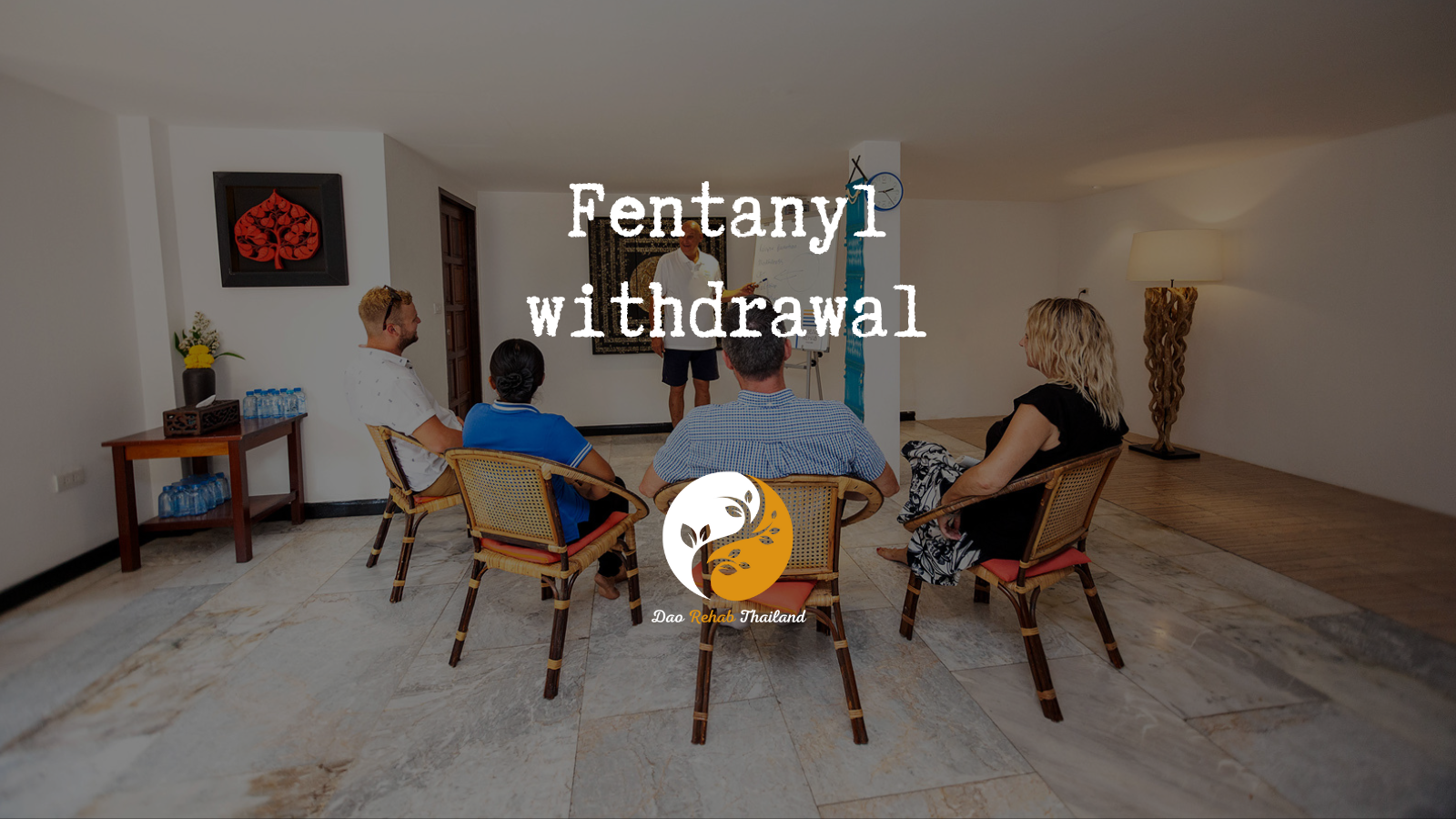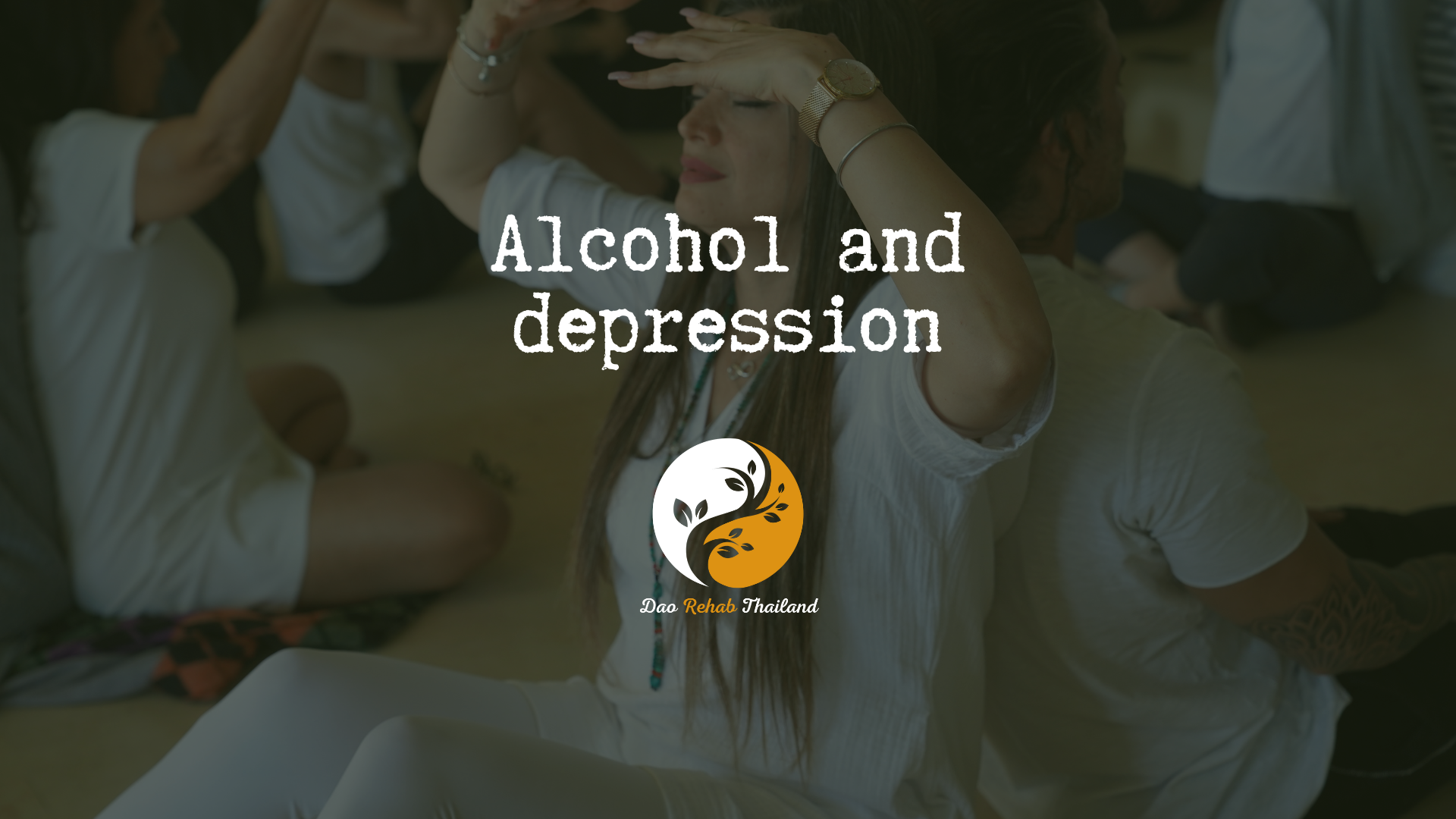
Fentanyl withdrawal-Holistic rehab in Thailand
Fentanyl withdrawal
“Turning the impossible into possible”

"Detox from Drugs at a Luxury Holistic Center in Thailand and Israel"

Fentanyl withdrawal-Holistic rehab in Thailand
Fentanyl is a synthetic opioid painkiller, 50 to 100 times more potent than morphine. Fentanyl is primarily used to relieve very severe pain, especially in cancer patients and in cases of major surgery. Here is a historical overview of fentanyl:
"Holistic Center for Trauma, Addiction, and Mental Imbalance Treatment in Thailand"
“Come to the beginning of your journey to freedom from addiction to alcohol, drugs, and pills, and rediscover your life within the serene embrace of DaoTherapy Rehab in Thailand—where holistic healing meets empowering recovery.”
DaoTherapy Holistic Rehab
Key Elements of Drugs Detox:
Medical Supervision: Drugs detox must be conducted under medical supervision, as the body may experience withdrawal symptoms. These can include nausea, anxiety, muscle aches, and insomnia. A medical team will monitor and manage these symptoms to ensure the patient’s safety and comfort.
Holistic Therapies:
Holistic Therapies: Many detox programs incorporate holistic therapies such as mindfulness, yoga, and meditation to help individuals cope with stress and anxiety during the detox process. These therapies support the mind-body connection and contribute to overall recovery.
Tapering Process
Tapering Process: Drugs detox often involves a gradual tapering of the drug to reduce withdrawal severity. Doctors will slowly decrease the dosage over time to allow the body to adjust to lower levels of the substance.
Psychological Support:
Psychological Support: Like any addiction recovery process, detox from Drugs includes psychological support. This can involve counseling, therapy, or support groups to address the mental and emotional aspects of addiction.
Post-Detox Treatment:
Post-Detox Treatment: After completing detox, continuing treatment is crucial to prevent relapse. This often includes participation in ongoing therapy, group support, and the development of new coping strategies to maintain sobriety.
Fentanyl withdrawal: What you need to know about fentanyl withdrawal, what are the causes of addiction to prescription pills:
The causes of addiction to prescription drugs are complex and vary from person to person, and include a combination of genetic, psychological, environmental, biological, and personal factors.
Genetic factors:
Genetic predisposition: Some people are born with a genetic predisposition to addiction. Studies show that there is a genetic inheritance that increases the risk of addiction.
Families with a history of addiction: Those who have parents or first-degree relatives who have struggled with prescription drug addiction may be at a higher risk of addiction.
Fentanyl withdrawal: Psychological factors:
Mental disorders: People who suffer from depression, anxiety, personality disorders, or post-traumatic stress disorder (PTSD) may turn to drugs to cope with the symptoms of these conditions.
Low self-esteem: A sense of low self-worth can lead to drug use as a way to escape a painful reality or to improve their sense of self-worth.
Stress and Mental Overload: People who experience chronic stress or increased mental overload may use drugs to relieve stress.
Feelings of inferiority and dysfunction are another psychological factor that can contribute to prescription drug addiction. We will detail this in the context of psychological factors for addiction:

contact us
Contact us with your questions
We would love to speak with you! Feel free to reach out with any questions.

get in touch
Schedule a free consultation
Schedule a free consultation with our team and let’s make things happen!
Historical background and development of fentanyl
Fentanyl is a synthetic opioid painkiller that is 50 to 100 times more potent than morphine. Fentanyl is primarily used to relieve severe pain, especially in cancer patients and during major surgery. Here is a historical overview of fentanyl:
Development and early use
1. Initial development: Fentanyl was first developed by Belgian chemist Paul Janssen in 1959. Janssen wanted to create a drug that would be more potent than morphine but with fewer side effects.
2. Initial approval: Fentanyl entered medical use in the early 1960s. It was initially marketed as a general anesthetic and surgical pain reliever under the trade name Sublimaze.
Medical uses and further development
3. Additional forms: In the 1990s and onwards, additional forms of fentanyl were developed, including transdermal patches (Duragesic), sublingual tablets (Actiq), and nasal sprays, which made the drug more accessible for the treatment of chronic and severe pain.
4. Medical applications: Fentanyl is mainly used to treat chronic pain, cancer pain, and post-operative pain. Its advantage is its rapid onset of action and relatively short duration of action, which allows for flexibility in use.
The problem of addiction and public danger
5. The spread of illegal use: Starting in the 2000s, fentanyl began to spread on the black market and be produced illegally. Due to its great potency, it became a commonly abused drug, which led to a sharp increase in overdose deaths.
6. The Opiate Epidemic: In the United States and other countries, the illicit use of fentanyl has contributed significantly to the opioid epidemic. Counterfeit fentanyl poses a significant risk due to its high overdose potential.
Control and Response Efforts
7. Legislative and Regulatory Efforts: Governments and various health agencies are taking steps to restrict the use of fentanyl and prevent the spread of the illegal drug. These include tighter prescription oversight, professional education for healthcare professionals, and public awareness campaigns.
8. Development of Alternatives and Treatments: Scientists continue to search for alternatives to fentanyl that provide effective pain relief with less risk of addiction and dependence. Efforts are also being made to develop treatments and interventions to prevent addiction and manage its consequences.
Fentanyl continues to be an important tool in medicine for relieving severe pain, but it should be used with great caution due to the high potential for addiction and the health risks it poses.
Information about fentanyl and its mechanism of action
Fentanyl and its mechanism of action
Introduction
Fentanyl is a synthetic opiate used primarily for very severe pain relief. It was first developed in the 1960s by Belgian chemist Paul Janssen. Fentanyl is best known for its potency, which is 50 to 100 times stronger than morphine. It is commonly used in the treatment of chronic pain, cancer pain, and post-operative pain, as well as in medical anesthesia.
Mechanism of action
Fentanyl works by binding to μ-type opiate receptors (myo) found in the central and peripheral nervous systems. When fentanyl binds to these receptors, it suppresses the transmission of pain signals in the brain and spinal cord.
Here is a breakdown of the mechanism of action:
1. Receptor binding: Fentanyl binds to μ-opiate receptors in the central nervous system, primarily in the brain and spinal cord.
2. Inhibition of pain transmission: Fentanyl’s binding to these receptors inhibits the release of neurotransmitters involved in pain transmission (such as substance P and glutamate), reducing the transmission of pain signals.
3. Effect on the brain: Fentanyl causes the release of dopamine in the brain’s reward system, which leads to a feeling of euphoria. This is one of the reasons why the drug can cause dependence and addiction.
4. Respiratory depression: One of the most dangerous side effects of fentanyl is respiratory depression. Binding to μ-opiate receptors in the respiratory centers of the brain can reduce the respiratory rate to the point of complete cessation in cases of overdose.
Fentanyl is available in different forms
Fentanyl is available in different forms of administration, depending on the medical needs:
Transdermal patches: used to relieve chronic pain over time (for example, Duragesic).
Buccal tablets**: For the treatment of sudden and severe pain (e.g., Actiq).
Nasal sprays: For rapid absorption in emergencies.
Injectable solutions: For use in surgery and general anesthesia.
Medical uses of fentanyl
Analgesia: Used in conditions of severe chronic pain, such as cancer pain.
Anesthesia: Used for general anesthesia in surgery because of its strength and rapid effect.
Postoperative pain management: Due to its rapid and effective effect.
Risks and side effects
Respiratory depression: The main danger of fentanyl overdose is respiratory depression, which can lead to death.
Dependence and addiction: Due to its effect on the reward system in the brain, fentanyl can cause dependence and addiction.
Additional side effects: Dizziness, nausea, vomiting, constipation, excessive sweating, drowsiness, confusion, and more.
Fentanyl is a very strong drug that requires careful use and strict medical supervision. Due to the high risks of misuse and overdose, it should only be used according to medical instructions.
Common side effects of Fentanyl:
Fentanyl, being a very strong opiate, may cause a wide range of side effects, some of which may be serious. Here are some of the common and serious side effects of Fentanyl:
Common side effects:
1. Drowsiness: Fentanyl can cause a feeling of tiredness and drowsiness.
2. Nausea and vomiting: Side effects are especially common at the beginning of use or when changing the dose.
3. Dizziness: A feeling of dizziness can occur and can sometimes cause falls.
4. Constipation: Like other opiates, fentanyl can cause severe constipation.
5. Headache: Some users report headaches.
6. Dry mouth: A dry mouth can be bothersome.
7. Increased sweating: Another symptom that can occur is increased sweating.
Serious side effects of fentanyl:
1. Respiratory depression: One of the most dangerous symptoms of fentanyl is respiratory depression, which can lead to slowed breathing and even complete cessation in severe cases.
2. Low blood pressure: Fentanyl can cause a sudden drop in blood pressure.
3. Bradycardia (slow heart rate): The heart rate can slow down dangerously.
4. Hallucinations: There are reports of hallucinations (false visions) and delusions.
5. Confusion: Fentanyl use may cause confusion and mood swings.
6. Severe allergic reaction: A severe allergic reaction may occur, including rash, itching, swelling (especially of the face, tongue, and throat), severe dizziness, and difficulty breathing.
7. Dependence and addiction: Fentanyl is a strong opiate and therefore there is a high risk of developing physical and mental dependence on it, which may lead to addiction.
8. Depression: Prolonged use can cause the development of depression.
Preventing side effects of using Fentanyl
Correct dosage: It is important to carefully follow the dosage given by your doctor and not exceed it.
Medical monitoring: Close medical monitoring can help with early identification and treatment of side effects.
Proper nutrition: Drinking enough water and eating fibrous foods can help prevent constipation.
If serious side effects occur or an overdose is suspected, seek immediate emergency medical help.
Fentanyl addiction
Fentanyl addiction is a medical condition in which a person develops a physical and psychological dependence on fentanyl, a very strong opiate used primarily for severe pain relief. Addiction can lead to uncontrolled use and serious health consequences, including life-threatening ones. Here is a breakdown of fentanyl addiction:
Signs and symptoms of fentanyl addiction
1. Increased use: The need to take larger doses of fentanyl to achieve the same effect.
2. Physical dependence: The body becomes accustomed to the presence of the substance and develops a dependence on it, so that not taking the substance causes withdrawal symptoms.
3. Psychological dependence: A constant psychological need to use fentanyl, even when there is no pain that justifies it.
4. Drug seeking: Investing considerable time and effort in trying to obtain fentanyl, including repeated visits to different doctors to obtain a prescription.
5. Ignoring side effects: Continuing to use fentanyl despite the appearance of serious side effects.
6. Neglecting duties: Neglecting work, family, and friends due to the need to use fentanyl.
7. Uncontrolled use: Using fentanyl in unadvised ways, such as injecting or taking higher than recommended doses.
Withdrawal symptoms
When stopping the use of fentanyl, withdrawal symptoms may occur, including:
Pain: Severe pain in the muscles and joints.
Increased sweating: Excessive sweating.
Nausea and vomiting: Constant feeling of nausea and vomiting.
Anxiety and depression: Severe feelings of anxiety and depression.
Insomnia: Difficulty sleeping.
Shivering: Chills and tremors.
Hallucinations: In severe cases, hallucinations can occur.
Risk factors for addiction
Long-term use: Long-term use of fentanyl, even at low doses.
Family history: Genetic predisposition to addiction to psychoactive substances.
Mental state: Depression, anxiety, or other mental disorders.
Use of other addictive substances: Use of alcohol or other drugs increases the risk of addiction.
Treatment for fentanyl addiction
Treatment for fentanyl addiction includes a combination of medical, psychological, and supportive approaches:
1. Medical detoxification: A supervised process of stopping fentanyl use in a medical facility, which includes treatment for withdrawal symptoms.
2. Supportive medications: Danger of using medications such as methadone or buprenorphine to relieve withdrawal symptoms and prevent relapse.
3. Psychological therapy: Individual or group psychological therapy, including therapy using the Tao Therapy method to treat the roots of the addiction.
4. Support Groups: Participating in support groups such as Narcotics Anonymous (NA) or other groups that provide ongoing support.
Prevention
Education and Awareness: Raising awareness of the dangers of addiction among users and healthcare professionals.
Ongoing Monitoring: Monitoring patients taking fentanyl over time.
Fentanyl addiction is a serious problem that requires immediate professional attention and treatment to prevent serious health and mental health consequences.
Psychological Support:
Psychological Support: Like any addiction recovery process, detox from Subutex includes psychological support. This can involve counseling, therapy, or support groups to address the mental and emotional aspects of addiction.
Prescription drug withdrawal treatments that exist:
Prescription Drug Withdrawal Methods Around the World
1. Medical Detoxification
Controlled Process: Medical detoxification is the first step in the addiction treatment process. During this process, the use of prescription drugs is stopped under medical supervision, while medications are given to relieve withdrawal symptoms.
Symptom Relief: Medications given can include anxiety-relieving, pain-relieving, and seizure-preventing medications.
2. Psychotherapy Treatment Using the Tau Therapy Method
Cognitive-Behavioral Therapy Using the Tau Therapy Method: This treatment focuses on identifying and changing negative thought and behavior patterns related to addiction.
Behavioral Therapy Using the 12-Step Approach: Used primarily to treat addicts with personality disorders, and teaches coping skills and emotional improvement.
Psychodynamic Therapy: Focuses on exploring the emotional connections and early experiences that led to addiction.
3. Group Therapy and Social Support
Support Groups: Groups such as Narcotics Anonymous (NA) and Alcoholics Anonymous (AA) offer support from former addicts through regular meetings.
Family Therapy: Involves the family in therapy to improve family relationships and support.
4. Alternative and Complementary Therapy from Taotherapy
Meditation and Yoga: These methods help reduce stress, anxiety, and improve self-awareness.
Acupuncture: Often used to reduce withdrawal symptoms and drug cravings.
Proper nutrition and exercise**: Improve overall health and help the body recover.
5. Rehabilitation Programs
Inpatient Rehabilitation Centers: Patients are in a treatment center under full supervision, receiving psychological, medical, and
support care.
Outpatient Rehabilitation: Patients continue to live at home but come to the rehab center for treatment and training.
6. Innovative Technologies
Biofeedback: This technology helps patients learn to control physical reactions and reduce stress.
Virtual Reality Therapy: Virtual reality therapy to recreate situations that trigger drug cravings and learn to cope with them.
7. Holistic and Spiritual Methods
Art and Music Therapy: Used for emotional expression and processing experiences.
12-Step Programs**: Based on spiritual principles and focused on personal responsibility and group support.
Summary
Drug detoxification methods are diverse and vary according to the patient’s needs and local policies. Different approaches are often combined to achieve optimal results, taking into account the patient’s physical, mental, and environmental conditions.
Common Fentanyl Withdrawal Symptoms
Common Fentanyl Withdrawal Symptoms
Physical:
Muscle pain: Extremely severe pain, especially in the back and limbs.
Weakness and fatigue: A feeling of persistent lack of energy.
Excessive sweating: Especially at night, a typical symptom of opiate withdrawal.
Vomiting and diarrhea: Imbalance in the digestive system.
Runny and watery eyes: A symptom reminiscent of flu symptoms.
Spasms and seizures: In more severe cases.
Fever and chills: A feeling of alternating cold and heat.
Increased blood pressure and rapid heart rate.
Mental:
Anxiety: Increased feelings of stress and anxiety.
Restlessness: Inability to relax or sit still.
Depression: A feeling of deep sadness and low mood.
Strong desire to use: Craving, an intense need to use the drug again.
Sleep disturbances: Difficulty falling asleep or frequent awakenings at night.
Irritability and aggression: Overly strong emotional reactions to various situations.
Duration of symptoms:
Days 1–3: Physical symptoms begin, mainly pain, sweating, and diarrhea.
Days 3–7: Mental symptoms increase, such as anxiety and depression.
Week 1 and beyond: Some physical symptoms decrease, but cravings and mental difficulties may persist.
Recommended treatment:
Close medical monitoring: Especially because of the risk of seizures or cardiovascular problems.
Emotional support: Psychological counseling or support groups.
Medication: Using methadone or buprenorphine to relieve symptoms.
Relaxation techniques: Meditation, deep breathing, or moderate exercise.
Fentanyl withdrawal is a very challenging process, and requires appropriate professional guidance to reduce risks and increase the chances of success.








